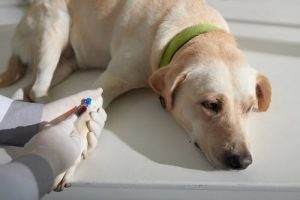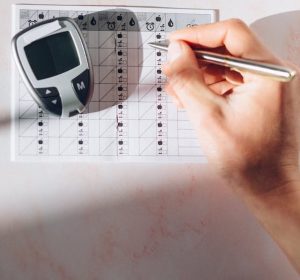A blood glucose curve in dogs is a series of blood tests over 12-24 hours. Vets use the results to calculate how much insulin your diabetic dog needs to control their symptoms.
Blood glucose curves are an essential part of managing diabetes in dogs. They help vets find the best dose of insulin when your dog first starts treatment. They’re also repeated after changes in dose or to investigate problems with control. The test is usually carried out in a vet practice, but more and more owners are learning to do this at home, where pets are more relaxed.
What it’s for
What is a blood glucose curve and why is it important?
A blood glucose curve provides information about your dog’s glucose levels. And how they change over 12-24 hours. Measuring glucose levels every 1-2 hours throughout a ‘normal’ day allows the vet to see how glucose rises and falls with feeding or exercise.
- Blood glucose levels rise after a meal. Rising glucose triggers insulin release.
- Insulin moves glucose out of the blood and into cells or storage.
- Exercise, stress or illness burn up more glucose, so blood glucose levels fall.
- If there’s not enough insulin in the body, sugar levels rise too high after meals.
- If there’s too much insulin around, blood sugar levels fall too far with exercise.
- Periods of too high or too low blood glucose indicate poorly controlled diabetes.
- The information is used to select or alter your dog’s insulin dosage.
How it’s done
What does a blood glucose curve involve?
Blood glucose tests involve collecting blood samples from your dog at regular times throughout the day.
Blood glucose curves at a vet practice
- Your dog stays at the practice for the day.
- The vet measures their blood glucose before starting the insulin treatment.
- They repeat the test after your pet eats and at regular times, every 2 hours throughout the day (and sometimes overnight).
- Results are used to create a graph that shows when glucose rises and falls and by how much.
- A blood glucose curve is usually repeated every time your dog’s insulin dose is altered.

The ‘downside’ of doing a glucose curve in a vet practice is that some dogs either won’t eat at the vets, or they get stressed. Often it’s both. And not eating or stress will both affect the results.
Blood glucose curves at home
These have the advantage that pets are relaxed in their own home and in their usual daily routine. The blood glucose curve created is a more accurate picture of blood glucose levels throughout the day.
- The vet practice will show you how to take a small blood sample from your dog’s ear, pad or lip.
- Test the sample with a glucometer – a simple human blood glucose testing device
- Record the results at home and either supply these or a graph to your vet.
- Also note down how much insulin and food you give and the times.
- There are online apps to help generate glucose curves – Pet Diabetes Tracker App (Caninsulin), RVC Pet Diabetes App.

- A glucometer device
Testing at home won’t suit every pet or pet parent. They will need to go to the vet practice. Or the vet may advise fitting a continuous glucose monitoring device (CGM).
Continuous glucose monitoring
- The newest option to monitor blood glucose is ‘continuous glucose monitoring’.
- This uses a small device attached to your dog. It automatically records glucose levels.
- A sensor attaches to the probe and sits on the surface of the skin. The vet will place the probe and sensor on your pet’s neck or somewhere your pet can’t bite, lick or scratch it
- The sensor is secured in place and protected with a bandage or t-shirt.
- You can download an app that reads the glucose results from the sensor.
- The probe and sensor can stay in place for up to 14 days.
There are multiple advantages to continuous glucose monitors:
- No blood tests and no need to see a vet.
- Less stressful for pets and owners.
- Conventional testing every 2 hours provides 8-10 blood glucose results at most. Continuous glucose monitors can read glucose every 1-5 minutes, up to 1400 results in a single day.
- Continuous glucose monitors (CGM’s) use far fewer resources (needles, blood test strips, swabs).
CGM kits are still in development. So the technology is far from perfect. Up to a quarter of the sensors fitted by trained vets fail to work properly. Movement, body condition and bleeding can all affect how well the sensors work. But they’re improving all the time.
Costs
How much does it cost to do a blood glucose curve?
The cost of a blood glucose curve will depend on where and how the test is carried out
Vet practice blood glucose test: £££
- Hospital day charges – depend on size of pet and length of stay – roughly £20-40
- Blood sampling and testing – roughly £20-30 per sample (usually 5-6 samples)
- Vet costs for curve interpretation and medical advice.
Home test costs: ££
- Glucometer – £15-£40 – or your practice may be able to lend you one
- Test strips
- Sterile lancets or needles to prick the ear
- Vet interpretation of the test results.
Continuous glucose monitoring: ££-£££
- The sensor kits cost between £58-65
- You can download the app on a smartphone to read the sensor. A hand-held separate monitor costs around £58 – £70
- Vet charges to fit the sensor and interpret results will vary between practices, likely to be in the region of £150-200
Risks
Are blood glucose curves safe for dogs?
Blood glucose curves are very safe for dogs. Any small ‘risks’ are related to sampling and include:
- Bleeding, bruising or haematoma formation at the sampling site
- Infection
Recovery tips
How to help your dog after a glucose curve
There are usually no recovery problems after glucose curves in dogs, as sedation or anaesthesia is not used.
When to worry
When to worry about a blood glucose curve
The vet will examine a blood glucose curve and assess whether insulin doses should be altered to control your dog’s symptoms. They will be looking out for prolonged high sugar levels or times of lower than normal blood glucose.
Call a vet without delay if :
- You record a glucose level below 3.3 nmol/l at home and your dog is unsteady on their feet, vacant, weak or panting.
Speak to a vet if you notice:
- Bleeding that doesn’t stop within minutes
- Redness or irritation at a sampling site
Joii can help with:
- How to carry out a blood glucose curve at home
- How to read a glucose curve
- Safe places and ways to take a blood sample at home








